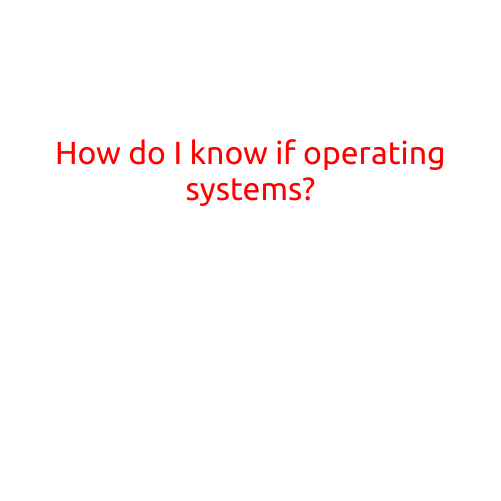
How Do I Know if I’m Running Too Many Operating Systems?
In today’s digital age, operating systems (OS) have become an essential part of our daily lives. From computers and laptops to smartphones and tablets, OS plays a vital role in managing and coordinating the various functions and applications that run on our devices. However, with the increasing number of devices and OS options available, it’s not uncommon for individuals to find themselves running multiple operating systems simultaneously. But how do you know if you’re running too many operating systems?
Signs of Running Too Many Operating Systems
Here are some common signs that you might be running too many operating systems:
- Confusion and Fragmentation: If you find yourself constantly switching between different operating systems, you might start to feel confused and disoriented. You might struggle to remember which OS you’re currently using and how to navigate its features.
- Overwhelming Customizations: With multiple operating systems, you might end up customizing each one separately, leading to overwhelming clutter and disorganization. This can make it challenging to find specific settings or configurations.
- Compatibility Issues: Different operating systems often have different hardware and software requirements. If you’re running multiple OS, you might experience compatibility issues, such as incompatible software, missing drivers, or hardware malfunctions.
- Storage Space and RAM Drain: Each operating system requires its own storage space and memory (RAM) to run smoothly. If you’re running multiple OS, you might notice a significant decrease in storage space and RAM availability, leading to slower performance and overall system slowdown.
- Security Vulnerabilities: With multiple operating systems, you’re increasing the risk of security vulnerabilities and potential attacks. Each OS has its own set of security updates and patches, which can become cumbersome to manage and update.
When is it Necessary to Run Multiple Operating Systems?
While running multiple operating systems might seem overwhelming, there are instances where it’s necessary or beneficial:
- Different Devices, Different OS: If you have multiple devices, such as a computer, laptop, and smartphone, each with its own OS, it’s essential to keep each device operating within its respective environment.
- Development and Testing: Programmers, developers, and beta testers often require multiple operating systems to test their software, apps, and prototypes.
- Legacy System Support: If you need to support or maintain older systems or legacy software, running multiple operating systems might be necessary to ensure compatibility.
Best Practices for Managing Multiple Operating Systems
If you find yourself running multiple operating systems, here are some best practices to help you manage the situation effectively:
- Keep Each OS Separate: Install each OS on a separate device or dedicate a separate partition for each OS.
- Regularly Update and Patch: Regularly update and patch each OS to ensure security and bug fixes.
- Streamline Customizations: Use a centralized management tool or a single configuration file to streamline customizations across all OS.
- Prioritize and Focus: Prioritize tasks and focus on one OS at a time to avoid confusion and distractions.
- Consider a Unified Environment: Consider migrating to a single, unified operating system if the benefits outweigh the drawbacks of managing multiple OS.
Conclusion
In conclusion, while running multiple operating systems can be beneficial in certain situations, it’s essential to be aware of the potential drawbacks and take steps to manage the complexity effectively. By recognizing the signs of running too many operating systems and implementing best practices, you can ensure a smooth, secure, and efficient computing experience. Whether you’re a developer, gamer, or simply a tech-savvy individual, understanding how to manage multiple operating systems will help you navigate the ever-changing world of technology with confidence.





